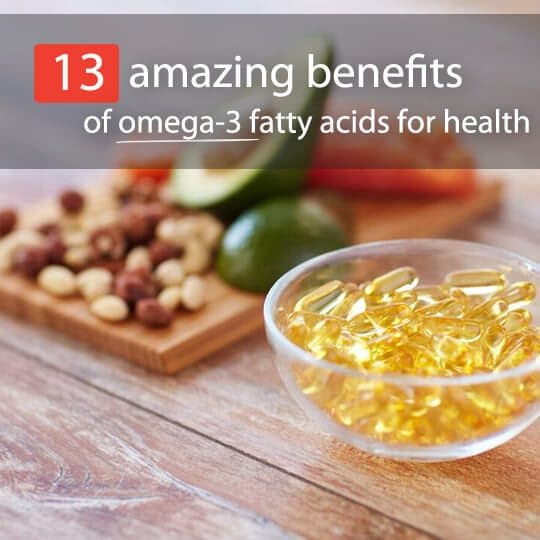Fat … It’s something a lot of people try to avoid because they assume eating it will expand their waistline. No one wants that! Well, the truth is, some fats will. If you’re eating cheeseburgers and cupcakes on the daily, then yes, you can expect to grow out of your pants. On the flip side, though, not all fats are created equal.

There are healthy fats that your body needs in order to function properly and survive. For example, Omega-3 fatty acids rank among one of the most important essential nutrients out there today.
A study published in the American Journal of Clinical Nutrition stated low Omega-3 levels can increase a person’s chance of death. Here’s another scary fact – most people fail to consume enough Omega-3 fats, making Omega-3 deficiency one of the largest killers in the U.S.
Before we talk about Omega-3 benefits and why you need them in your diet, let’s take a quick look at the different types.
Types Of Omega-3 Fats
The two main types of Omega-3 fats that you may have heard of before are eicosapentaenoic acid (EPA) and docosahexaenoic acid (DHA). EPA and DHA are usually found in animal-based foods, such as fish. A third type of Omega-3 is alpha-linoleic acid (ALA), which is found in plant-based foods such as flaxseed, chia seeds, and hemp seeds.
While all three types are important to consume, the most beneficial Omega-3 fats are EPA and DHA. That doesn’t mean snacking on ALA-rich foods won’t help boost your health, though. In fact, ALA is actually converted into EPA and DHA in the body at a very low ratio.
1) Heart Health
Numerous studies show that Omega-3 fats benefit heart health in a major way. According to The American Heart Association, consuming sufficient amounts of Omega-3 fats can lower high blood pressure and reduce fatty plaques inside artery walls. It can also reduce the risk of arrhythmias (abnormal heartbeats), stroke, and heart attack. There’s proof to back up all of this.
In one Italian study, researchers monitored 11,324 heart attack survivors. They found patients who started taking fish oil supplements had a reduced risk of suffering another heart attack or stroke. Then, researchers in America studied a completely different group of men. They found that men who consumed fish at least once a week had a 50 percent lower risk of dying from a sudden cardiac event than men who ate fish less than once a month.
So, how much fish should you eat in order to reap these heart health benefits? Well, doctors say eating just two servings of fish a week can lower your risk of stroke by as much as 50 percent. Like anything, though, you can eat too many Omega-3 fats (I’ll talk more about this below). So don’t eat fish for every meal.
2) Reduces Bad Cholesterol Levels
One reason Omega-3 fats benefit heart health is because they help lower LDL (bad cholesterol) levels and triglycerides (fats in the blood). There have been several studies that found this to be true. One study, for example, compared the efficiency of krill and fish oils in reducing triglyceride levels in rats. Researchers found both oils were successful.
Along with lowering bad cholesterol and fat levels, Omega-3 fats can also increase HDL (good cholesterol) levels. Researchers point to the Eskimos as the perfect example. They eat a diet rich in Omega-3 fish and tend to have increased HDL cholesterol and decreased triglycerides. It’s the same for people who follow the Mediterranean-style diet.

3) Fights Diabetes
Researchers have found people with diabetes often have high triglyceride levels and low HDL levels. As I just mentioned above, these are two things Omega-3 fatty acids counteract. That’s a big plus for people who suffer from diabetes. Additionally, Omega-3 fats can lower apoproteins (markers of diabetes).
If you have diabetes and are thinking of introducing Omega-3 supplements or Omega-3 foods into your daily diet, make sure to consult with your doctor first. While researchers have found a positive correlation between Omega-3 fats and diabetes, everyone’s body is different.
4) Digestion
Gas, bloating, and indigestion … oh my! Dealing with digestive issues is both painful and embarrassing. If you are one of the 25-45 million Americans who suffers from Irritable Bowel Syndrome (IBS) then you may want to start eating foods rich in Omega-3 fatty acids. Studies show Omega-3s can help relieve IBS symptoms, like the ones I just mentioned.
Since Omega-3 fats have been proven effective at fighting inflammation, they are also said to ease Inflammatory Bowel Disease (IBD) symptoms. Crohn disease and ulcerative colitis are two types of IBD.

5) Fights Depression
Since the brain needs fat to function, researchers have found Omega-3 fats play an extremely important role in achieving good mental health. In addition to learning and behavioral patterns (which I’ll talk more about in a minute), researchers decided to take a closer look at the impact of Omega-3 fats on depression and mood. Several studies have proven it effective.
In one British study, scientists gave a group of depressed patients a daily dose of EPA. After three months, over two-thirds of the group reported a 50% reduction in their symptoms. They saw significant improvement in the following:
- Feelings of sadness
- Inability to work
- Fatigue
- Low libido
- Inability to sleep
All of the patients in this study had previously tried antidepressant medications, such as Prozac.
In another study, researchers found people who took Omega-3 fatty acids in addition to their prescription antidepressants had a greater improvement in symptoms than those who took antidepressants alone.
A third study found Omega-3 fats helped protect new mothers against postpartum depression. While researchers continue to study the impact Omega-3 fats have on mood, it’s clear there is a direct connection.

6) ADHD
One thing is for sure — children with attention deficit hyperactivity disorder (ADHD) are more likely to have low levels of Omega-3 fats. In one study, researchers examined nearly 100 boys. They found the boys with lower levels of Omega-3 fatty acids had more learning and behavioral problems than boys with normal Omega-3 fatty acid levels.
Given these findings, the logical thought would be to give a child with ADHD sufficient amounts of Omega-3 fats. While this certainly couldn’t hurt, studies examining whether Omega-3 fats help improve symptoms of ADHD show mixed results.
7) Children’s Learning Ability
Along with mood and behavioral issues, Omega-3 fatty acids are also linked to children’s learning ability. The findings in this next study may surprise you. According to research published in American Journal of Clinical Nutrition, children ages 3 to 5 who consumed Omega-3 fats as infants scored higher on intelligent tests. Other studies have linked low DHA levels with poor memory and reading skills. The bottom line here is – Omega-3 fats are extremely beneficial for children!
7) Schizophrenia
While more research needs to be conducted before we can say for sure if Omega-3 fats benefit Schizophrenia, preliminary clinical evidence suggests it can improve symptoms.
8) Cognitive Decline (Dementia and Alzheimer’s)
Low Omega-3 fatty acid levels have been linked to cognitive aging, Dementia, and Alzheimer’s disease. In one study that looked at senior citizens with age-related cognitive decline, scientists found those who took 900 milligrams of DHA every day scored slightly better on a computerized memory test than those who received a placebo. Not all research studies have reached the same findings, though, which is why more testing is needed. Still, with the amount of research that’s been done so far, scientists believe DHA could play a major role in helping protect against such illnesses.
9) Reduces Risk Of Cancer
Researchers say eating foods rich in Omega-3 fats can reduce your risk of getting colon cancer, breast cancer, and prostate cancer. That’s because Omega-3s work to suppress inflammation, which is a catalyst for certain cancers. Along with a reduced risk of developing cancer, Omega-3 fats have also been shown to prevent worsening.
10) Ease Rheumatoid Arthritis Symptoms
Rheumatoid arthritis is an autoimmune disease that causes inflammation in the joints. While Omega-3 fats probably won’t slow down the progression of Rheumatoid Arthritis, studies have found it can help alleviate symptoms. The key is to reduce inflammation, which Omega-3 fats have been proven to do. For this reason, Omega-3 fats can help in easing joint pain and easing morning stiffness.

11) Reduce Risk of Osteoporosis
Osteoporosis is a disease of the bones. It happens when a person loses too much bone or makes too little bone. Researchers have found Omega-3 fatty acids can help increase calcium levels, which improves bone strength. Some studies also suggest that people who don’t consume enough Omega-3 fats are more likely to suffer bone loss. This can weaken the bones, making them very susceptible to breaks and fractures.
12) Menstrual Pain Relief
If you’re a woman, you know how crippling menstrual cramps can be. Have you ever laid in the fetal position while holding a heating pad on your lower abdomen? If you answered “yes,” know you’re not alone. While a heating pad can definitely help, you may be surprised to hear that consuming Omega-3 fats can too! In one Danish study, researchers had a group of 78 women with menstrual pain take either seal oil, fish oil alone, fish oil with vitamin B-12, or a placebo. They found women taking seal oil, fish oil alone, and fish oil plus B-12 had fewer symptoms and less pain than those taking the placebo. So next time it’s that time of the month, reach for a fish oil supplement or enjoy a nice plate of wild caught salmon!
13) Skin Disorders
Most people shop for their beauty products at the drugstore, searching for the perfect skin cream or cleanser. But what if I told you, the best place to search for beauty products was actually the supermarket? That’s right! The secret to better skin isn’t only what you put on top of it, it’s also what you eat.
A diet rich in Omega-3 fats can help reduce the signs and symptoms of acne, eczema, and psoriasis. One way Omega-3s help is by reducing inflammation, which is the underlying cause of many skin conditions. Even if you’re blessed with flawless skin, introducing Omega-3s into your diet can help strengthen your skin cells and give you an even healthier look.

Omega-3 Foods
Now that you’ve read about Omega-3 benefits, you can see how important they are for your overall health. Here’s the big problem, though — most people aren’t getting enough of the key nutrient. Did you know your body can’t make Omega-3 fats on its own? Rather, the only way to feed your body these important fats is to take a fish oil supplement or eat foods rich in Omega-3s. Here is a list of top Omega-3 foods:
- Salmon
- Sardines
- Anchovies
- Mackerel
- Tuna
- Trout
- Herring
- White Fish
- Chia Seeds
- Flax Seeds
- Hemp Seeds
- Walnuts
- Natto
- Egg Yolks
- Brussels Sprouts
- Kale
- Spinach
- Watercress
If you are not a fan of these foods you can always take a daily fish oil supplement. When it comes to dosing your fish oil supplement, it should be based on the amount of EPA and DHA (rather than the total amount of fish oil). For proper dosing, it’s always a good idea to speak to your primary care physician.

Omega-3 vs Omega-6
It’s important not to confuse Omega-3 fatty acids with Omega-6 fatty acids. While they sound similar, they aren’t. Omega-6 fats are found in vegetable oils, such as corn oil, sunflower oil, and soybean oils. They are also used in commercial snack foods and salad dressings. While Omega-3 fats fight inflammation, Omega-6 can cause it.
I don’t want to make it seem like you should never consume Omega-6 fats. In fact, Omega-6s do have a place in a healthy diet. They just have to be eaten in a healthy proportion to Omega-3s. Most experts agree the Omega 6:3 ratio should range from about 1:1 to 5:1. Unfortunately, though, the ratio of the current American diet ranges from about 10:1 to 15:1. This can lead to a slew of health problems such as cancer, heart disease, and inflammatory conditions like arthritis.



